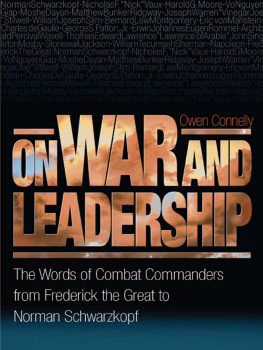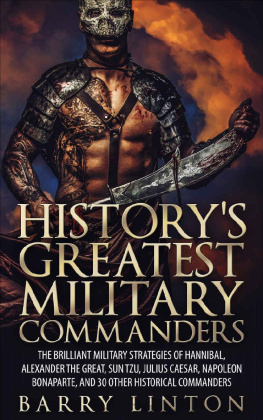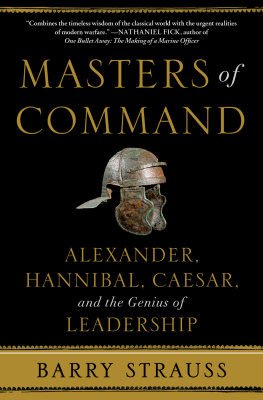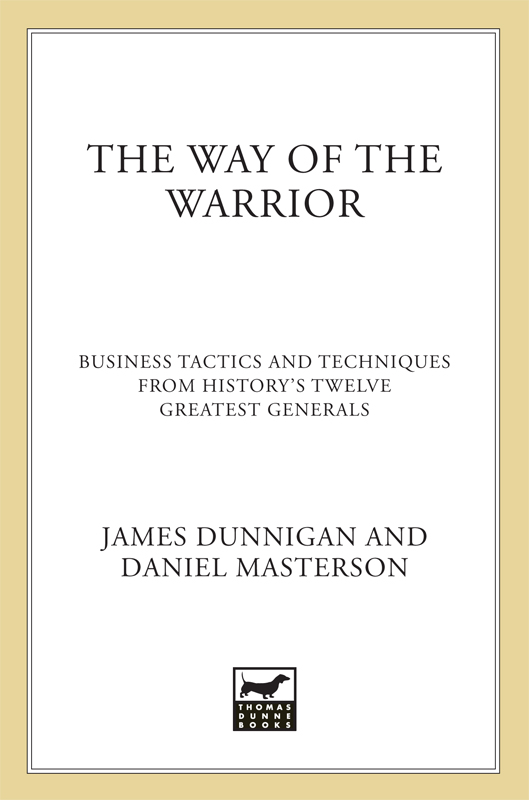Contents
Guide

The author and publisher have provided this e-book to you for your personal use only. You may not make this e-book publicly available in any way. Copyright infringement is against the law. If you believe the copy of this e-book you are reading infringes on the authors copyright, please notify the publisher at: us.macmillanusa.com/piracy.
CONTENTS
To the rest of the Mastersons: Darla, Chersti, Travis, Westen, and Daniel for their love, support, and patience.
A number of people with military and management experience read the manuscript and contributed many valuable comments and criticisms. Thus, we would like to thank Stephen B. Patrick, Bill Speer, Al Nofi, Mike Macedonia, Trent Telenko, Fun Fong, Kurt Aldag, Shaun Coyne, Tim Keenon, Neal Bascomb, Scott Rosenthal, Karen Little, and Mike Ley.
G REAT GENERALS AND successul managers have a lot in common. Dont be misled by the battles and fancy uniforms. The warriors of legend, the commanders who achieved dramatic feats on the battlefield, were, first and foremost, highly effective managers. Think about it. During a military career, a general might fight only a few, to a few dozen, battles. Most fight none at all. Campaigns would consume more time, often months or years of just moving troops around and, more importantly, keeping them fed, clothed, equipped, and ready for combat. But campaigns dont always result in many, or any, actual battles. The skills required to manage a campaign successfully were those that separated Great Captains from the rest of the pack. Thus most of a Great Captains time was spent managing. Before, or in between wars, it was all management. During wars it was still mostly dealing with a mountain of detail and nonlethal decision making. Generals who were poor managers often had their armies fall apart before battle was joined, or else quickly collapse under the stress of combat.
In war, it is preparation that makes the difference. If the troops reach the battlefield hungry, poorly trained, and with shabby equipment and weapons, they will not do very well. Indeed, they will probably lose. Actually, there have been so few competent generals through the centuries that the saying, its not a matter of whos better, but whos worse came into use. This quip recognized the fact that both sides in most battles were usually badly led, and victory often went to the side least unready for combat. But here we shall examine the cream of the crop, the Great Captains who so outclassed their competition, they usually rolled over a long string of opponents, restrained only by mortality or going one conquest too far.
While much is made of tactical skill when commanding troops in combat, even this is a talent developed from many years of practice and painstaking preparation. Training troops for battle is another of those management skills Great Captains possess, the ability to inspire their soldiers to endure months or years of drills, developing an edge that ultimately produces spectacular battlefield results.
In combat, the great military commanders have had to solve multiple problems quickly and often while new crises were developing around them. This ability to get things done while your world is falling down about your ears is a talent most people in business would like to have. The best examples of good management under stress can be obtained from the Great Captains of history. Then again, many highly regarded peacetime commanders have proved failures in the cauldron of combat. Thats another lesson from military history. Managing is one thing, managing combined with leading under fire is an altogether different animal, and a rare one to boot. A manager may do quite well when things are calm but then crumple under the pressure when the situation gets more, well, exciting.
Thus while the Great Captains were not businessmen, they did have to worry about managing. Great military commanders are, after all, managers most of the time. Victory in battle is 90 percent preparation and 10 percent taking care of unanticipated emergencies. How did the Great Captains do this? Our research indicates they did it using ancient, and still viable, management techniques. What we are doing in this book is spotlighting the techniques used by the Great Captains and pointing out how their use of these techniques provides useful lessons for todays managers.
Until this century, management was not discussed as a discipline. The ancients would sometimes speak of statecraft and tips on how to manage a farm. But for those rare few with a natural talent for managing large organizations, it was largely a process of reinventing the wheel each time a major military crisis brought into existence those large organizations known as armies. Until the past century or so, there was nothing like the large modern business to manage, except armies. It is amazing to see how each of the Great Captains of the past used the same, or very similar, techniques to organize their way to victory. We have gathered together this ancient wisdom and present it in terms modern business people can understand.
But the Great Captains also show us how to deal with what affects current businesspeople at every levelinformation overload. The Great Captains stood at the top of large pyramids of power. Masses of information, much of it fragmentary and suspect, washed over them. They had to come up with ways to deal with this in the days before telephones, CNN, and satellite communications. One of the greatest problems managers then, and now, have had to deal with is handling the masses of information coming in during times of stress. The ancients figured out how to handle it, as well as how to take care of time and space problems that still exist in our age of instant communication.
Where are the female Great Captains? Simple, there arent any. Women have been active in military affairs throughout the centuries, but not as universally or enthusiastically as the men. Part of the reason for this is tradition, but that in turn is based on more practical considerations.
Before muskets and rifles came into wide use during the last few centuries, combat was mostly about brute strength. The weapons, such as swords and spears, were wielded by hand. Bows required up to a hundred pounds of pull. Armor required strength to carry. A leader of warriors had to be more than a leader: he had to be someone the troops would respect as one of their own. Given that situation, there were far fewer opportunities for a military-minded female to get started on a military career, especially a career as spectacular as those studied here.
Not that female military leaders were absent. There were many, largely the able members of powerful families. Often, in times of crises, these women would step into a power vacuum and take charge of the troops.
Women have always been more prominent as national leaders, for that job does not require an apprenticeship in arms. Thus in the seventh century, as the victorious Arab Moslem armies swept across North Africa, they were brought up short by a Berber army led by a woman, the Kahena Dahiyan of Barbary. She was the leader of one of the Jewish tribes in the region, and she forged an alliance with the other nomadic tribes and settled peoples in order to resist the Arabs. She also led the army when need be and held off the Arabs for a decade. Her military skills led to several notable victories. But by the early eighth century, an endless supply of Arab troops and Arab money for bribes destroyed her coalition and her resistance.













